Campbell Street - Where the Old Shine is Just a Rub Away
By Ooi Geok Ling
FEATURE
IS A STREET merely a passage one goes through to get from one point to another? First of all, let’s differentiate it from a road. Before I can even type, naïve scenes appear in my head. I imagine bigger buildings on a road, more vehicles and moving ostensibly faster. A street, on the other hand… I see children on bicycles, more people than vehicles, more smiles, a newsstand, a coffee shop.
You can use “street” or “road” when you tell a child to “be careful when you cross the …” but the two are not always inter-changeable in a sentence. For example, “Penang has the best street food” or “don’t put me out on the streets” whereas it is “the road to progress” or “a salesman who’s always on the road”. We are not arguing semantics here, but the word “street” connotes much more than its physical meaning, even before we explore its socio-cultural aspects. I will even go so far as to say that a street simply has soul.

In 1989, the municipal council of Penang in conjunction with Pulau Pinang magazine organised a “Memory Of Our Streets” essay competition. It was part of a worldwide campaign by UNESCO “to encourage an awareness of the character of streets, through rediscovery of their past, as a pledge to the future.” That is the same reason for Penang Monthly’s homage to Campbell Street in this issue.
Physically, Campbell Street is only 500m long. It stretches from Penang Road to the Campbell Street Market with intersections at Cintra Street and Rope Walk. Those intersections dissect the street into three blocks of unequal lengths. In its heydays, a very diverse range of businesses thrived on Campbell Street, thus earning it the reputation of “the Fifth Avenue of Penang”. That was in the 60s and 70s, coinciding with my growing-up years. During that period, no gigantic cast iron arch announced entry into it.
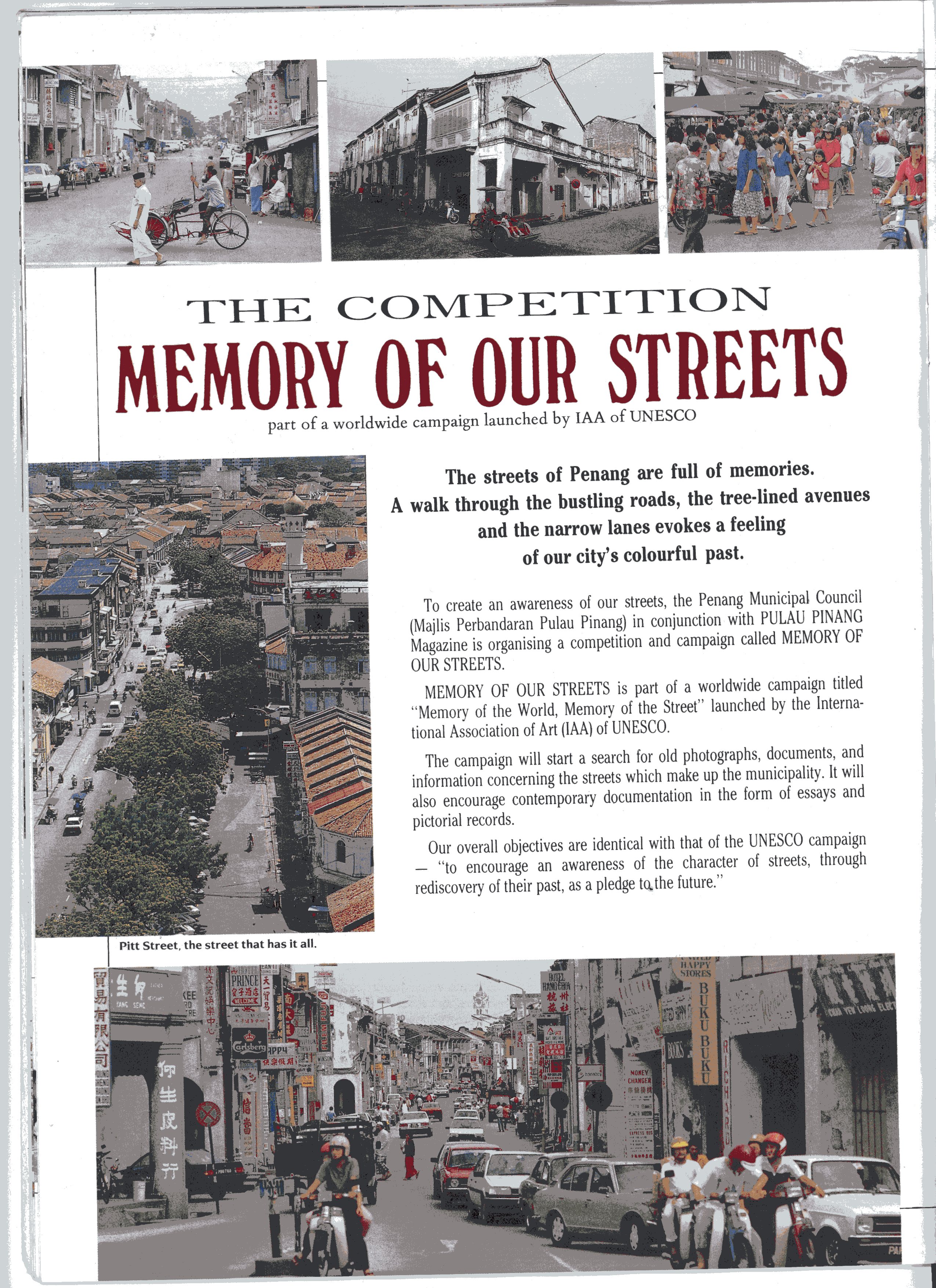
Interestingly, upper Campbell Street refers to its start at Penang Road, while in Chinese dialects, the “head” of Campbell Street is where the colonial-style Campbell Street wet market is, at the other end of the street.
The old buildings along Campbell Street are almost all still intact, save for a few three-storied ones which are now only facades. The street has lost most of its vertical signboards, though; these were once a favourite focus for photographers. What are left are few and far between. These showcase the diehards, the few still lucrative shops and a handful of hotels, cafes and pubs. The biggest category of still surviving retailers is jewellery and goldsmith shops.
Childhood Memories
Campbell Street was my night time playground as a child; the junction where it meets Penang Road was merely two minutes away by foot from the shop house I lived in on Transfer Road (now part of Hotel Penaga). Like an insect drawn to bright lights, I often hopped over to this vibrant street. There was always something interesting or new to see. It may be hard to imagine that today, but it used to be fairly safe (at least I felt so) for an eight-year-old to do that.
Where the Penang Road branch of Ban Heang Biscuits is today was a very popular shoe store named Zlin. I remember eyeing Dr Scholl’s Exercise Sandals there, but its price tag of RM49 put them beyond the reach of a pre-teen. I could only admire the beautiful grains of the beech wood foot bed each time I walked past Zlin’s open shelves to enter Campbell Street. That was probably when and where my love affair with shoes began.
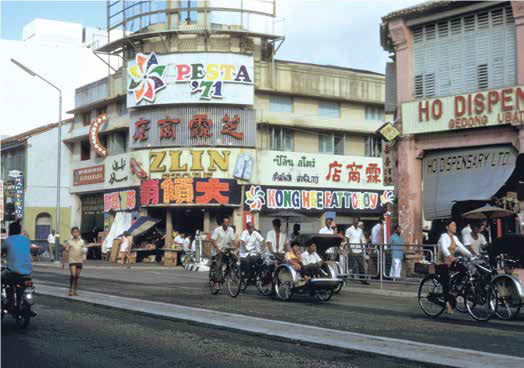
Remember the tagline “First to Bata, then to school”? The nearest Bata shoe store to my home was just two doors from Zlin. The Bata Badminton Master shoes with green rubber soles, white socks and the must-have whitener were the purchases I looked forward to every year end.

Incidentally, Zlin was the Czechoslovakian town where Bata shoes originated in. Someone had remarked on social media that Zlin used to sell Bata shoes before chain stores opened under the Bata brand. So that was the backstory of one of Penang’s earliest modern shoe stores.
Speaking of school, how many of you carried the mini-suitcase schoolbag in red and black tartan? No prize for guessing where I got mine from. I wish I had kept mine the way Dato’ Seri Dr. Anwar Fazal, a fellow lover of Campbell Street, still has his “first travel investment” of a Dionite hard shell suitcase.
Anwar recalls purchasing the suitcase in preparation for his prestigious Eisenhower Fellowship in the US in 1972. Campbell Street was the go-to place for bags and luggage and traces of that can still be seen today. Anwar continued going to Campbell Street to fix the wear and tear on his bags and suitcases. His favourite repair shop, until the business closed, was Tong Chai Tong, located at the junction of Campbell and Cintra Streets.
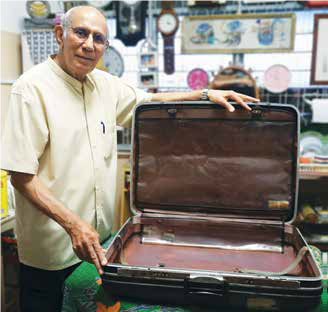
Festive Shopping
Chinese New Year was truly a big affair on Campbell Street. The celebrative shopping periods were much shorter than what malls now offer, with their very early fancy decorations. In the old days, most parents in Penang needed a rest period after buying school uniforms and books before suffering another shopping binge for the festivities.
Campbell Street would become extra lively as pop-up stalls lined the five-foot ways on both sides, like two red streams rolling down the incline. These stalls sold affordable clothes, shoes, accessories, festive goodies and lots of decorative items, including the almost-defunct Chinese New Year greeting cards. In the background, one could hear the blaring of familiar greeting tunes coming from vendors selling cassette tapes.
Today, this festive mood is not even a fragment of what it used to be. I wonder how the old shops selling clothes and shoes had survived, even during pre-pandemic times, stuck as they seemed to be, in a 70s time warp. Joo Wah Shoe Store diversified by adding inflatable beach toys and souvenirs to attract tourists. No obvious change to their shoe display was made – they just hung the new merchandise on their five-foot way for full visibility. I wonder if their business will resume once the MCOs are over; even then, we do not expect many tourists to return for some time.
Sadly, another shoe store with old-world charm closed for good last year. The couple who owned Kean Hin Shoes Supplies retired due to old age and mobility challenges. At the time of writing, they can still be seen moving in and out of their no-longer-a-shop house, though their shoes remained on display in the glass casings. The two columns flanking the shop still proudly proclaim in embossed Chinese calligraphy – “Modern sandals for men and women” on the left and “Superb quality European and American leather shoes” on the right.
Across the street from Kean Hin still stands Campbell Street’s oldest business on record. Kwong Tuck Sundries and Liquors was established in 1836 by the great-grandfather of its current 90-year-old proprietor, Woo Shee Kow, who lives above the shop. I still frequent it for normal sundries to make tong sui (literally translated as sweet water and refers to Cantonese soupy desserts) or once in a while to indulge in some yoon cheong, waxed sausage made of goose liver. Waxed or preserved meats and dried seafood, including fish maw and sea cucumber are the specialties Kwong Tuck is renowned for.
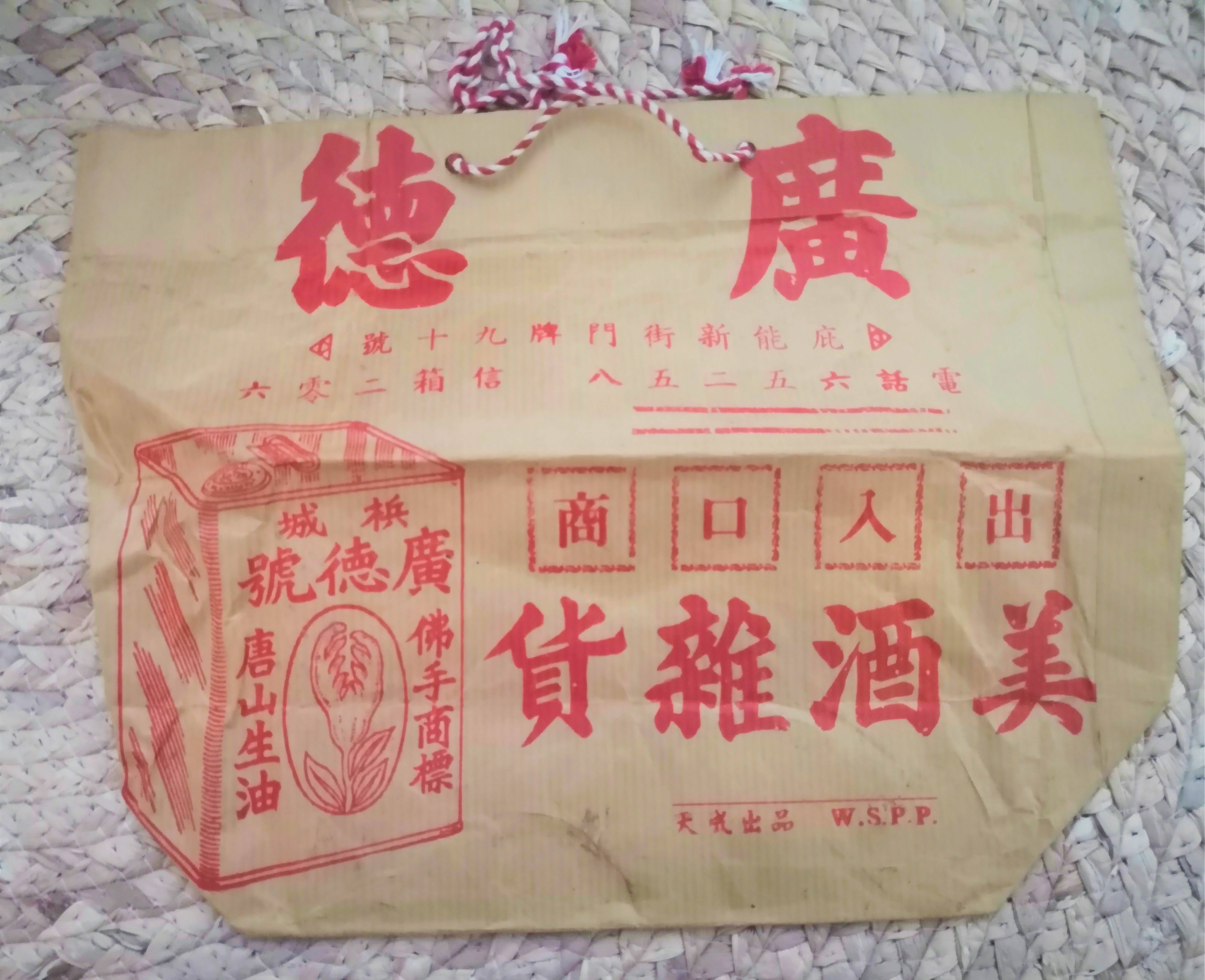
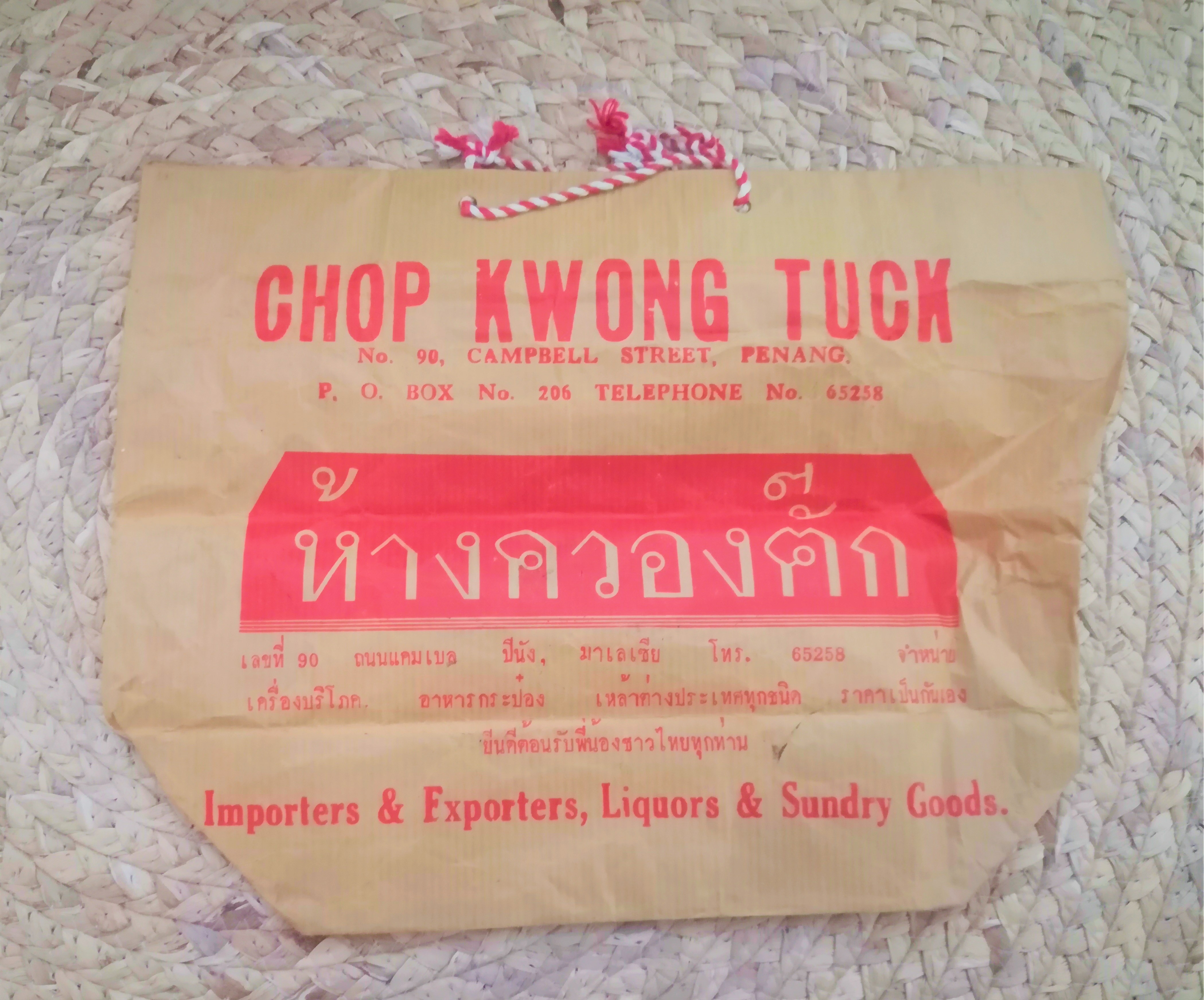
As of this year, they are selling online via their website, kwongtuck.com, and it is heartening to know that not only is their business not affected by the various lockdowns but that it is doing even better with more home cooks trying out more complex recipes. Before gift hampers wrapped in cellophane became popular, Penang people used to gift festive goodies in Kwong Tuck’s printed paper bag; big city folks always thought this a quaint idea and “very Penang”. If only Kwong Tuck would start printing those bags again, so that we can revive the tradition.
According to Austin Wong of Woo Hing Brothers, only four buildings on the portion of the road which stretches from his shop to Rope Walk survived a fire in World War II. The fire stopped just before Kwong Tuck. After learning this, I started to study the architecture more closely. Adjacent to Kwong Tuck, there are indeed no columns along the five-foot way of the rebuilt shops. I had not noticed that before!
Chicken Rice
The two oldest residents we know of on Campbell Street are residing in two of these four pre-war buildings. Austin’s mother, Madam Loo, is 91 years old and prefers to be independent in familiar surroundings. Austin recalls that her favourite hairdresser, Hoong Tho (Red Peach), was located just diagonally across the street, now occupied by Magnum 4D. She also enjoys the local food available in the neighbourhood.
For Hainanese Chicken Rice, however, Austin now has to go to Cintra or Chulia Street even though that dish was what Campbell Street was once famed for. Despite her fading memory, even my mother remembers Chip Seng Chicken Rice which was sandwiched between Woo Hing and Tho Yuen Restaurant, the latter always well-known for its dimsum and Cantonese-style noodles.
So, what happened to Chip Seng? According to an old article in Guang Ming Daily, Foo Say Chee (Hainanese) and Ooi Hak Say (Hokkien), had set up Chip Seng and revived the selling of chicken rice after the war. One of their old employees, Lau Hor Kan or more affectionately known as Kan Sook, or Uncle Kan, affirmed that Chip Seng had existed before he joined them in 1953. After two years, he left to work in the eatery next door. That was because “Tho Yuen had a bigger variety of food for its employees!” Kan Sook recalled that Ooi branched out in the late 50s to set up his own shop, Loke Hooi, just across the street. You can still see Loke Hooi’s name embossed in Chinese on the building facade even though the business ceased in the 80s. It is today an art space, Izu Zone, owned by Penang-born and Rome-based artist, HH Lim.
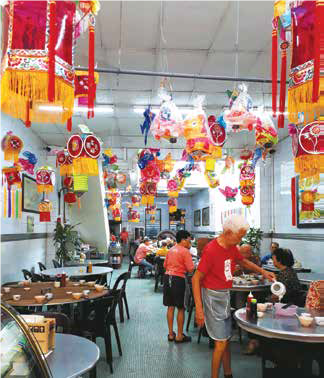
Foo eventually sold his business but Chip Seng continued to operate under a new management until Tho Yuen took it over in the late 80s. Tho Yuen’s heir apparent, Leong Chee Khong, joined his father and managed the newly acquired division; their restaurant expanded. Thus, that was how a Cantonese eatery ended up with Hainanese Chicken Rice on its menu.
When they ceased serving chicken rice two years ago, the only trace of Campbell Street’s chicken rice history is on Tho Yuen’s signboard. When dining-in-premises are allowed again, diners will surely miss the distinctive-looking Kan Sook, who decided to retire last year.
Succession
Ask Austin what his formula for their sustainability is now that the footfall on Campbell Street has shrunk considerably, and he attributes it to a pivotal business decision made in the 90s to carry only one brand – Rolex. He had contemplated moving to a mall in the 80s, but he must be glad about that decision now as he would be having the same issues with rental and pathetically low footfall which mall tenants presently have. His two children are running the business now.
Another good example of a well-sustained business on Campbell Street is Cheng Woh Medical Hall, currently managed by its fourth-generation successor, Lee Xi Wen and his still-active parents, Lee Tak Tsong and Yap Chee Bee. The shop doubled in size in 1988 after they took over Eng Huat Electrical Appliance Store next door. It has been airconditioned and modernised for convenient shopping; the retained medicine drawers and foot-tall glass jars behind a glass counter look interestingly like they are from half a century ago. My mother used to send me there to pick up simple items such as a particular brand of cough mixture. That item is still available in exactly the same packaging.
My Zoom conversation with the Lees was fruitful as they connected my memory dots for a fuller recollection. They confirm that there was indeed another Muslim restaurant adjacent to them. Originally Meerah, it was taken over by Taj in the 80s. They were friendly neighbours judging by an anecdote shared by Yap. After Xi Wen was born in 1985, the owner of Taj commented that she gave her son a good name as it sounded like Siva!
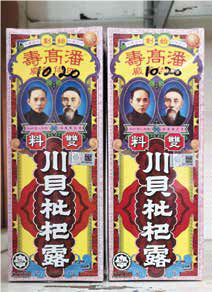
We also reminisced on their neighbours who ran perm parlours, a term you hardly hear these days. One was Hoong Sing (Red Star) and the other was Foong Lan. Another neighbour operated a tailoring shop and its signboard, Nam Poe, is still there even though the building has been completely taken over by her son’s watch and clock repair shop. And we did not forget to mention Wing Hing, the gramophone and record shop along the same row.
In stark contrast to Cheng Woh, Poh Aun Tong Medical Hall has not changed its interior or its business motto of “only pack when purchased”. The motto is a legacy which Chan Soo Sum, a qualified physician, inherited from her father and that she has been bent on keeping till today. You may be attended to by Chan before she prescribes the herbs you need. And if you wish, Poh Aun Tong also provides brewing services. While I was at the shop, a young lady showed up with a thermos flask to collect her order. I wonder how many medical halls still do that around Penang.
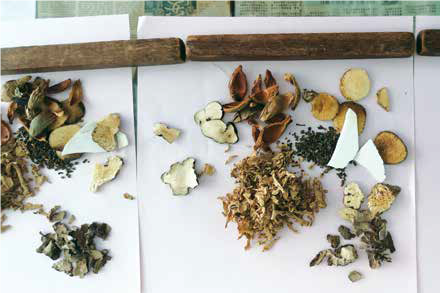
Pre- and Post-pandemic
Ten years ago, Campbell House was opened after being transformed from a neglected three-storey corner shop. It was one of the earliest boutique hotels to be started in George Town. With it came Il Bacaro, the first Italian restaurant in the inner city. You would expect an investment like that to put the spotlight on Campbell Street, and it did.
Gradually, accommodation of different affordability sprang up on the upper floors while cafes operated on street level.
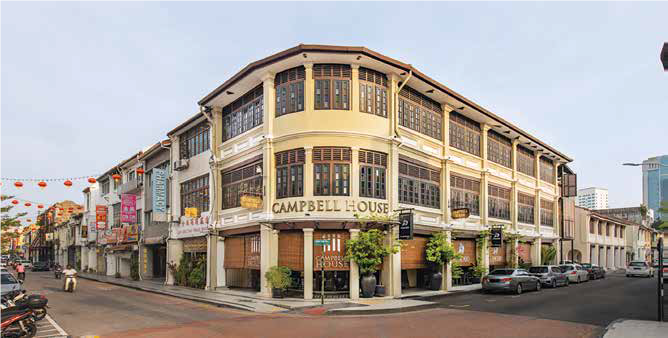
We also started seeing a lot more cars at night parked along the block where the jewellery shops are. There were even long queues to get into Safe Room Café for their signature nitrogen ice cream, while opposite, a new noodle house attracted crowds with their dough-kneading artistry using a long bamboo pole. Next door to it, a larger building which was formerly Kim How Jewellery, was repurposed into a hotel, café and lounge in 2017. KT Tan, one of its owners, said that Kim Haus started offering stand-up comedy sessions as a novelty in Penang, and since a regular venue was needed to support local talent.
More food and beverage outlets also opened on the next two blocks and were a welcomed change to the wholesale clothing shops which threatened to monopolise the street. Writer, a contemporary-design stationery shop, is another refreshing newcomer which gives diners and pedestrians purpose to linger for longer.
The evolution of Campbell Street happened organically, thanks to entrepreneurs who not only saw opportunities for profit but also wanted to contribute to the culture and arts scene in George Town. Perhaps a shot in the arm from the authorities and city planners will further boost the momentum of this upward trend. Furthermore, the pandemic has re-directed the interest of retailers away from malls to streetside shopping, a role-reversal of shoppers’ trend in the 80s which caused the decline of Campbell Street.
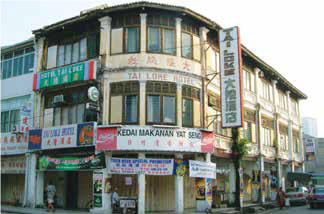
While the city council is looking for the perfect balance between pedestrians and cars, they may well aim higher, and make Campbell Street destination-worthy again. It already has a rich history, cultural heritage, good accessibility with supporting side streets, diversity, F&B and an old cinema building to boot – all cool factors for a vibrant street.
It just needs a bit of help in some departments. How about having curated outdoor activities, perhaps at the old Sun cinema? Add design-oriented touches to the streetscape. Bring back its signature vertical signboards. Provide better security. Introduce public transportation on Campbell Street.
And please, encourage shoe stores to return.
Ooi Geok Ling

likes trying most things once, provided they are not detrimental to her body or her pocket. Too much.



